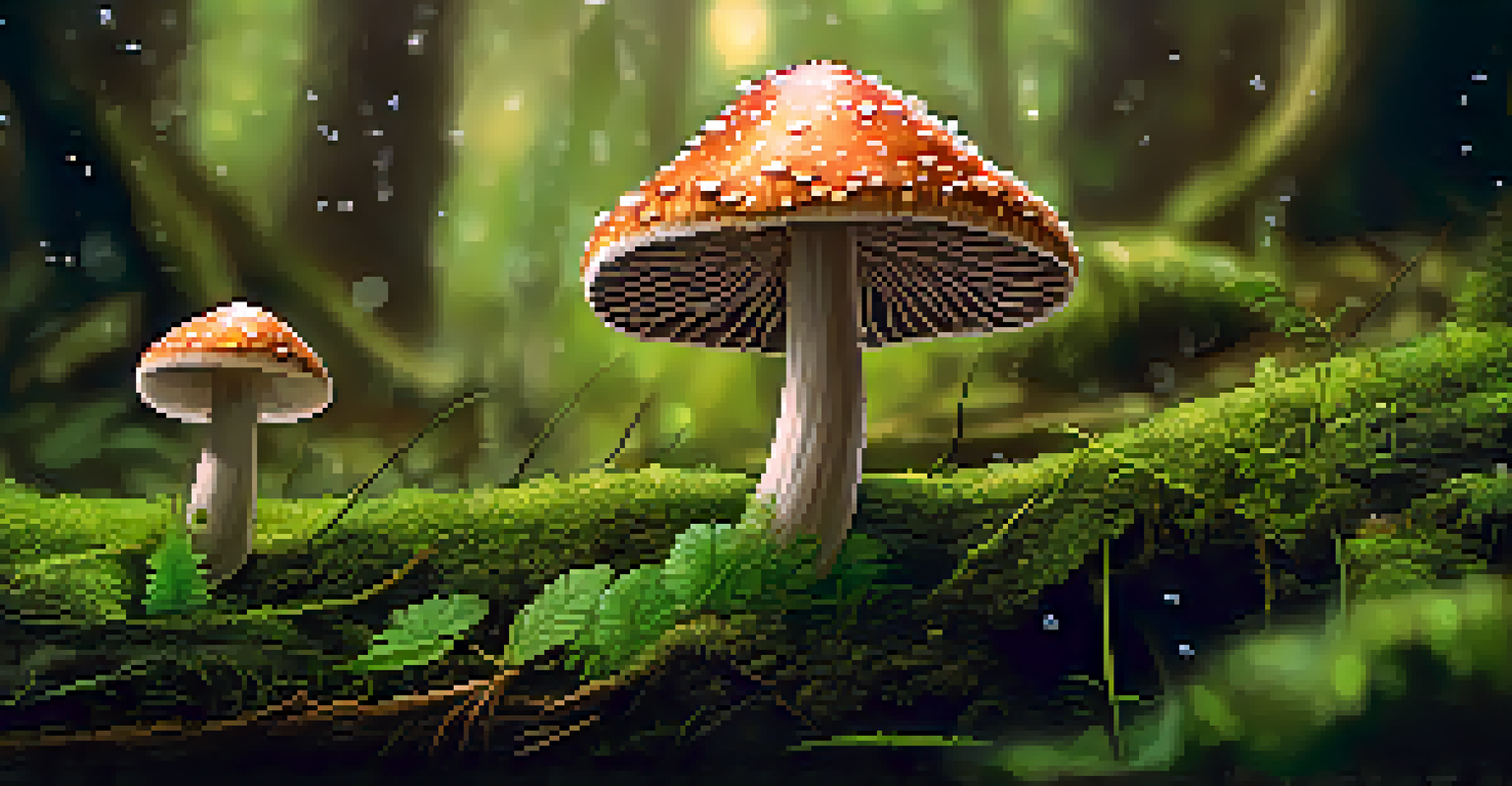Public Perception and Misconceptions of Entheogen Research

What Are Entheogens? Clarifying the Basics
Entheogens are substances that people use for spiritual or religious purposes, often derived from plants. Common examples include psilocybin mushrooms and ayahuasca, which have been used in various cultures for centuries. These substances can alter consciousness and facilitate profound experiences, yet they're often misunderstood.
The use of entheogens in a controlled, intentional context has the potential to offer profound healing and transformation.
Many people associate entheogens solely with recreational drug use, leading to a stigma that overshadows their potential benefits. This misconception can hinder meaningful discussions about their applications in mental health and therapy. By understanding what entheogens truly are, we can begin to appreciate their complex role in various cultures.
A clearer definition of entheogens helps to differentiate them from illegal drugs, promoting a more informed public dialogue. This differentiation is essential for destigmatizing their use and fostering open-minded discussions on their research and application.
Cultural Context: The Roots of Entheogen Use
Entheogens have deep roots in various cultures, often tied to spiritual practices and healing rituals. Indigenous communities around the world have used these substances for thousands of years, believing they connect them to the divine. This historical context is critical to understanding their significance beyond mere intoxication.

In modern society, many people are unaware of this rich heritage, leading to misconceptions about their use. Some might view entheogens as a trend or fad, rather than as part of a long-standing spiritual tradition. Recognizing this cultural significance can help shift perspectives towards a more respectful attitude.
Understanding Entheogens' Purpose
Entheogens are substances used for spiritual or therapeutic purposes, often misunderstood due to their association with recreational drug use.
By exploring the historical use of entheogens, we can appreciate their role in community bonding, healing, and personal transformation. This understanding lays the groundwork for more informed discussions about their potential benefits in contemporary contexts.
The Scientific Perspective on Entheogens
Recent research has begun to unlock the potential therapeutic benefits of entheogens, particularly in treating mental health disorders. Studies have shown promising results for conditions like PTSD, depression, and anxiety, challenging the stigma surrounding these substances. However, public perception often lags behind scientific findings.
Psychedelics can help us understand and connect with ourselves, and they can also help us connect with the world around us.
Many people still view entheogens as dangerous or purely recreational, ignoring the growing body of evidence supporting their safe use in controlled settings. This gap between science and public opinion can hinder funding and support for further research. Education about the scientific findings is essential to bridge this divide.
As more studies emerge, it’s crucial to communicate these findings effectively to the public. Doing so can foster a more nuanced understanding of entheogens, leading to more informed opinions and potential acceptance in therapeutic contexts.
Common Misconceptions About Entheogens
One of the most prevalent misconceptions is that entheogens are the same as recreational drugs. While they can alter perception, their usage is often rooted in profound spiritual or therapeutic experiences. This misunderstanding can lead to the dismissal of their potential benefits.
Another myth is that all entheogens are harmful or addictive. In reality, many studies suggest that when used responsibly, these substances can have therapeutic effects without causing addiction. Addressing these misconceptions is vital for changing the narrative surrounding entheogen research.
Cultural Significance Matters
Recognizing the historical and cultural context of entheogen use can shift perceptions and promote a more respectful dialogue about their benefits.
These misconceptions often stem from a lack of education or exposure to accurate information. By debunking these myths, we can create a more informed society that appreciates the complexities of entheogens and their potential contributions to mental health and spirituality.
The Role of Media in Shaping Perceptions
Media portrayal plays a significant role in shaping public perceptions of entheogens. Often, sensationalized stories focus on the negative aspects, such as addiction or misuse, while overlooking positive research findings. This skewed representation can lead to fear and misunderstanding among the public.
Conversely, some media outlets have started to highlight the potential benefits of entheogen research, showcasing personal stories of healing and transformation. These narratives can help humanize the discussion, making it relatable and less intimidating. However, balanced reporting is key to providing a well-rounded perspective.
As consumers of media, it's essential to critically evaluate the information presented about entheogens. Encouraging responsible journalism can foster a more informed public discourse that reflects the complexities of entheogen research and its societal implications.
The Importance of Education and Awareness
Education about entheogens is crucial in dispelling myths and misconceptions. By providing accurate information, we can promote a more informed discussion about their benefits and risks. Awareness campaigns can play a pivotal role in changing public perception.
Workshops, lectures, and community discussions can help demystify entheogens, making the topic more approachable. Engaging with experts in the field can also provide valuable insights, helping to build a bridge between scientific research and public understanding. This engagement is vital for fostering a culture of informed dialogue.
Education is Key to Acceptance
Increasing awareness and education about entheogens can dispel myths and support their potential therapeutic applications in mental health.
Ultimately, increasing awareness and understanding can lead to greater acceptance of entheogen research. As public perceptions shift, we may see more support for studies that could unlock the therapeutic potential of these substances, benefiting countless individuals.
The Future of Entheogen Research and Perception
As research on entheogens continues to grow, so too will public perception surrounding them. With increasing evidence supporting their therapeutic benefits, we can anticipate a shift towards more acceptance and understanding. This evolution in perception is crucial for paving the way for future studies and applications.
However, this shift won't happen overnight. It requires collaboration among researchers, educators, and the media to ensure that accurate information is disseminated. By working together, we can address misconceptions and promote a more balanced view of entheogen research.

Looking ahead, the future of entheogen research holds promise for improving mental health treatment and fostering spiritual exploration. As we move forward, it’s essential to maintain an open dialogue that embraces both the scientific and cultural aspects of these powerful substances.